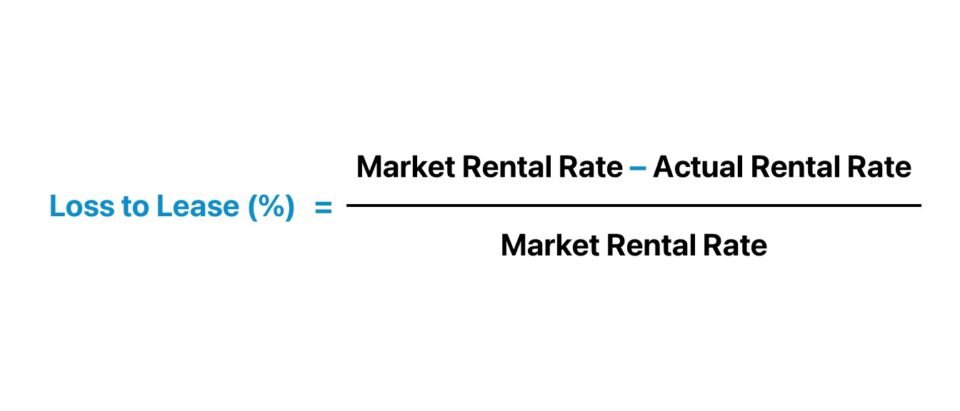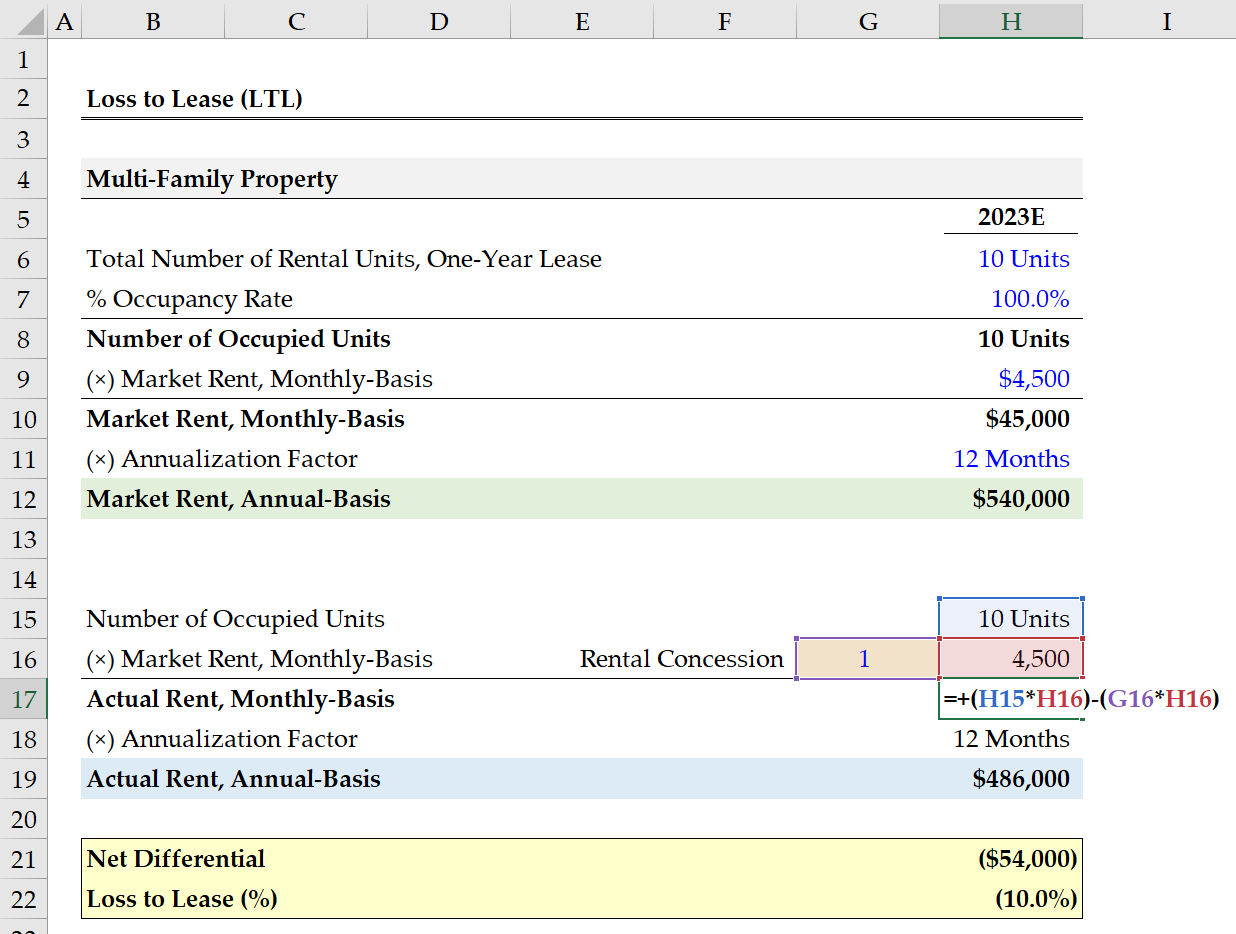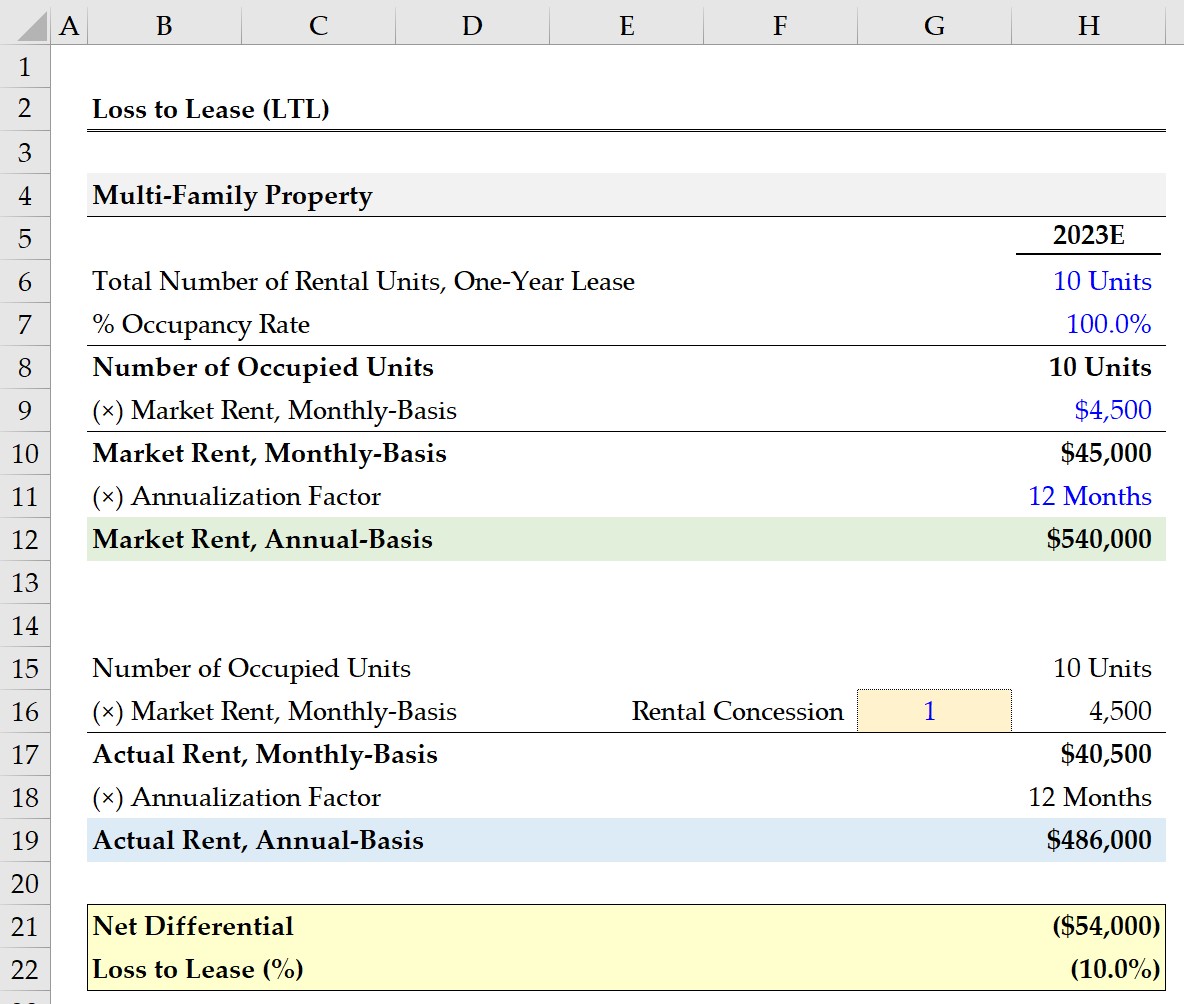- What is Loss to Lease?
- What is the Definition of Loss to Lease (LTL)?
- How to Calculate Loss to Lease?
- Loss to Lease Formula (LTL)
- Loss to Lease (LTL) vs. Gain to Lease (GTL): What is the Difference?
- Loss to Lease Calculator (LTL)
- 1. Real Estate Multi-Family Property Assumptions
- 2. Loss to Lease Calculation Example (LTC)
What is Loss to Lease?
Loss to Lease (LTL) is a multi-family real estate metric that quantifies the loss in potential revenues attributable to a difference between a property’s market rental rate and the actual rent paid by a tenant, expressed in percentage form.

What is the Definition of Loss to Lease (LTL)?
In the multifamily real estate market, the term “loss to lease” describes the difference between a unit’s market rental rate and the actual rent stated on the signed lease agreement.
The loss to lease is more relevant to scenarios whereby there are long-term leases in place.
Given the longer-term commitment, there is far more risk and uncertainties in the real estate market (and the global economy) that could impact the current market rate.
Conceptually, the loss to lease (LTL) is the difference between a property’s in-place rent – the payment amount stated on the contract – and the market rent as of the present date.
The cause often stems from external factors, such as unpredictable fluctuations in the economic conditions, yet there are other instances in which the property owner intentionally offers incentives to encourage tenants to sign a long-term lease.
For example, the near-term outlook on the real estate market might seem unfavorable from the perspective of the property owner, i.e. demand in the real market will sharply decline, causing prices to drop off.
Therefore, securing a long-term tenant – a steady source of income as part of a contractual obligation – can be worth the trade-off rather than undertaking a risky bet on the rental market recovering.
One notable distinction to understand here is that the “loss” incurred is not truly a monetary loss, per se. But rather, the loss is more like a lost opportunity to reap more potential profits.
The property owner, at the end of the day, is not obligated to pay the difference, so the loss alludes more towards the potential revenues that could have hypothetically been generated, i.e. there is no direct “out-of-pocket” loss incurred by the property owner.
How to Calculate Loss to Lease?
In commercial multifamily real estate, the loss to lease (LTL) metric is the estimated revenue lost from the market rent diverging from the actual in-place rent stated in the terms of the leasing contract.
The loss to lease (LTL) can be derived by dividing the market rental rate by the actual rent (“in-place”) and then subsequently subtracting one.
In order for the figure to be compared relative to other comparable properties, the resulting figure must then be converted into a percentage by multiplying by 100.
- Positive Percentage → The property owner is the benefiting party (Market Rent < Actual Rent)
- Negative Percentage → The tenant is the benefiting party (Market Rent > Actual Rent)
Note: The gross effective rent will oftentimes be used to determine a potential tenant’s income qualification and be clearly stated as the monthly rental expense on the lease. However, there will also be language around any concessions offered, such as the number of free months, which reduces the actual monthly rental expense, i.e. termed the net effective rent.
Loss to Lease Formula (LTL)
The formula to calculate the loss to lease is the difference between the market rate of a property and its in-place contractual rate.
For example, suppose the current market rental rate is $2,000 per month, and the rental rate stated on the leasing agreement is $1,820 per month.
- Market Rental Rate = $2,000 per Month
- Actual Rental Rate = $1,820 per Month
The loss to lease is the difference between market rent and in-place rent, which is $180 per month.
- Loss to Lease ($) = $2,000 – $1,820 = $180 per Month
The $180 per month difference as a standalone metric is not enough to provide much insight to guide any financial decisions.
Considering the metric is stated on a gross basis (and is not standardized), the more practical method of measuring the loss to lease is to divide the market rental rate by the in-place contractual rent and then subtract one.
- Loss to Lease (%) = ($2,0000 ÷ $1,820) – 1 = 0.10, or 10%
The Wharton Online and Wall Street Prep Real Estate Investing & Analysis Certificate Program
Level up your real estate investing career. Enrollment is open for the Feb. 10 - Apr. 6 Wharton Certificate Program cohort.
Enroll TodayLoss to Lease (LTL) vs. Gain to Lease (GTL): What is the Difference?
The inverse of the “loss to lease” is termed the “gain to lease”. The two occurrences are virtually identical. However, the beneficiary is switched, as one would reasonably expect.
- Loss to Lease (LTL) → If the current market rent exceeds the actual in-place rent paid by a tenant, the scenario would be categorized as a loss to lease since the property owner incurred a monetary loss (and the tenant benefits from the locked-in structure of the lease).
- Gain to Lease (GTL) → If the current market rent falls below the actual in-place rent, the circumstances are referred to as a gain to lease. Unlike the prior scenario, the property owner benefits because the actual rent paid remains fixed, irrespective of the market rate reduction.
If a multifamily investor is underwriting a property with a substantial loss to lease, the property could present an opportunity for the investor to acquire the property at a steep discount and increase the rent closer to the benchmark market rent of comparable properties.
The loss-to-lease metric in multifamily investing is thereby a critical metric for analyzing multifamily properties and deciding where to allocate capital.
By implementing a more optimal pricing strategy and integrating value-add improvements to the property, the loss to lease should decrease, while the property value rises from the increase in demand in the market.
Loss to Lease Calculator (LTL)
We’ll now move on to a modeling exercise, which you can access by filling out the form below.
1. Real Estate Multi-Family Property Assumptions
Suppose a property owner is estimating the loss to lease (LTL) on a multifamily real estate property investment based on different pricing strategies.
The property has a total number of 10 units available for rent, with a market rental rate of $4,800 based on recent historical data and market research, i.e. the pricing of comparable properties located nearby (“comps”).
- Total Number of Rental Units, One-Year Lease = 10 Units
But unexpectedly, the outlook on the real estate market (and the broader economy) seems unfavorable because of the widespread concerns regarding a long-term recession.
In an effort to mitigate the risk of an unoccupied unit, the property owner decides to be risk-averse by offering one month for free to all tenants who sign a lease during a limited period of time.
Because the property is located in a city with significant demand, offering one month was enough for all 20 units to be quickly occupied, i.e. it reaches a vacancy rate of zero.
- Occupancy Rate = 100%
- Occupied Units = 10 Units
The one-month free offer reduces the annual rental payment per unit from $540,000 to $486,000, reflecting a price reduction of 9.1%.
- Actual Rent, Monthly-Basis = $40,500
In contrast, the market rent on a monthly basis, inclusive of all ten tenants, is $45,000.
- Market Rent, Monthly-Basis = $45,000
- Net Differential, Monthly-Basis = $45,000 – $40,500 = $4,500
Instead of reducing the price stated on the contract, the property owner offers one free month for all tenants signing a twelve-month lease, which is a relatively common practice in the rental market.
The formula to determine the actual rent, expressed on a monthly basis, starts by multiplying the number of occupied units by the market rent.
Once complete, the rental concession offered by the property owner (i.e. the one free month) is multiplied by the market rent, which is then subtracted from the initial step.
2. Loss to Lease Calculation Example (LTC)
If no concessions were offered, the total rental income paid by each tenant would amount to $540k on an annual basis.
- Market Rent, Annual-Basis = $45,000 x 12 Months = $540,000
The property owner is offering one free month to incentivize potential tenants to sign a twelve-month lease – but in the prior section – we already adjusted the market rent to calculate the actual rent for all tenants on a monthly basis.
- Actual Rent, Annual-Basis = $40,500 x 12 Months = $486,000
The net differential between the two figures – $540,000 less $486,000– amounts to $54,000, which reflects the concept of loss to lease.
- Net Differential ($) = $540,000 – $486,000 = ($54,000)
In conclusion, we’ll divide the net difference by the market rent on an annual basis to arrive at a loss-to-lease rate of 10.0%, which can be perceived as the foregone “upside” that the property owner lost to ensure a full occupancy rate.
- Loss to Lease (%) = ($54,000) ÷ $540,000 = (10.0%)








